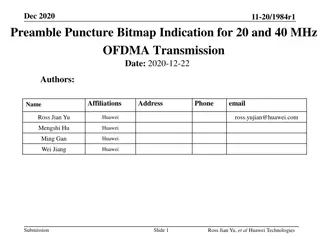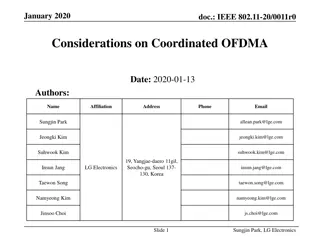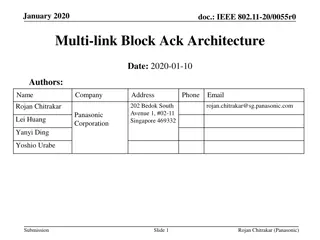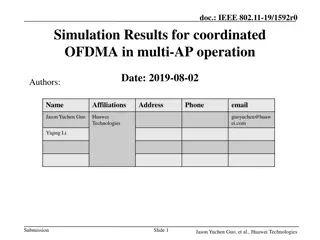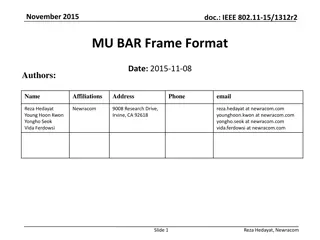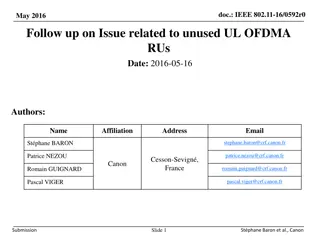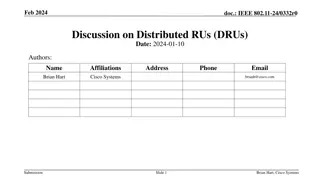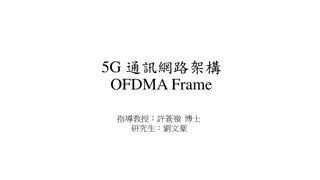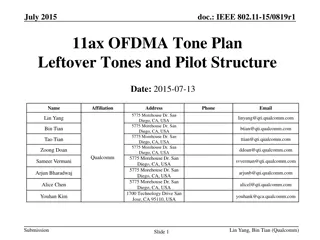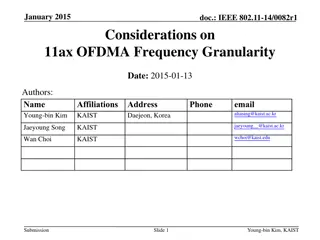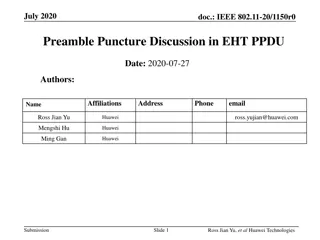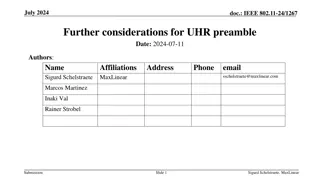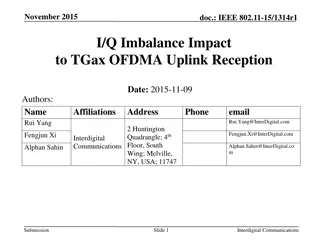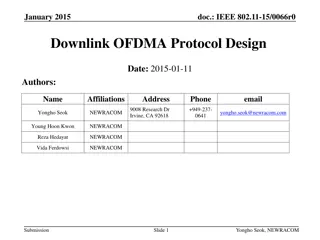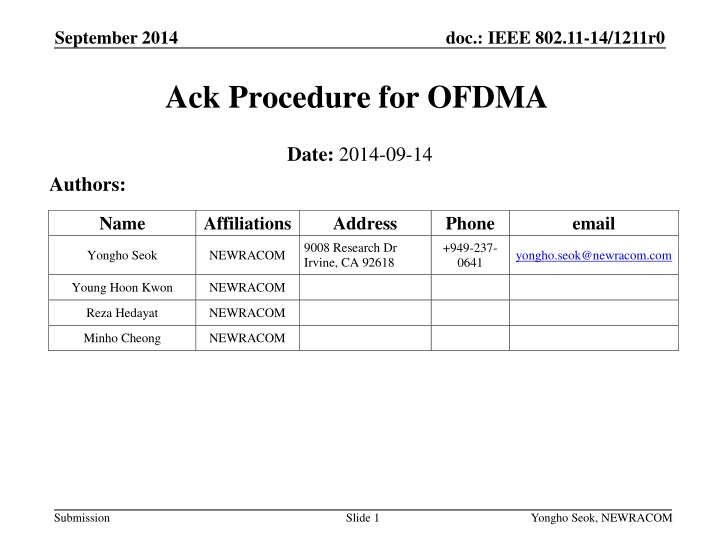
Efficient Acknowledgement Procedures for OFDMA Networks
Enhance user experience in WLAN with efficient Ack procedures for OFDMA tech. Explore Sub-channel & Channel-based Ack methods for sustained efficiency. Proposed protocols maximize network performance by optimizing Ack frame transmission, ensuring seamless data flow in OFDMA systems.
Uploaded on | 2 Views
Download Presentation

Please find below an Image/Link to download the presentation.
The content on the website is provided AS IS for your information and personal use only. It may not be sold, licensed, or shared on other websites without obtaining consent from the author. If you encounter any issues during the download, it is possible that the publisher has removed the file from their server.
You are allowed to download the files provided on this website for personal or commercial use, subject to the condition that they are used lawfully. All files are the property of their respective owners.
The content on the website is provided AS IS for your information and personal use only. It may not be sold, licensed, or shared on other websites without obtaining consent from the author.
E N D
Presentation Transcript
September 2014 doc.: IEEE 802.11-14/1211r0 Ack Procedure for OFDMA Date: 2014-09-14 Authors: Name Affiliations Address Phone email 9008 Research Dr Irvine, CA 92618 +949-237- 0641 Yongho Seok NEWRACOM yongho.seok@newracom.com Young Hoon Kwon NEWRACOM Reza Hedayat NEWRACOM Minho Cheong NEWRACOM Submission Slide 1 Yongho Seok, NEWRACOM
September 2014 doc.: IEEE 802.11-14/1211r0 OFDMA for High Efficiency WLAN OFDMA is a promising technology for enhancing the user experience by serving the heterogeneous users simultaneously But, in order to sustain the gain, the efficient MAC protocol design is very important Submission Slide 2 Yongho Seok, NEWRACOM
September 2014 doc.: IEEE 802.11-14/1211r0 OFDMA for High Efficiency WLAN For discussion purpose, we assume the following numerical parameters of OFDMA FFT size is increased 4 times as the following 256 FFT on 20 MHz channel, 512 FFT on 40 MHz channel, 1024 FFT on 80 MHz channel, 2048 FFT on 160 MHz channel One 256 FFT on 20 MHz channel is composed of four 64 FFT on 5 MHz channels One 5 MHz channel corresponds to one sub-channel in this presentation Submission Slide 3 Yongho Seok, NEWRACOM
September 2014 doc.: IEEE 802.11-14/1211r0 Ack Procedure for OFDMA In this presentation, we discuss the ACK procedures for OFDMA according to the unit of the channel bandwidth of the ACK frame Sub-channel based ACK Channel based ACK Submission Slide 4 Yongho Seok, NEWRACOM
September 2014 doc.: IEEE 802.11-14/1211r0 Proposed Ack Procedure for OFDMA Sub-channel based ACK ACK PPDU is transmitted on the sub-channel of the eliciting PPDU ACK policy field of all eliciting PPDU is set to a implicit Block ACK Request Submission Yongho Seok, NEWRACOM Slide 5
September 2014 doc.: IEEE 802.11-14/1211r0 Proposed Ack Procedure for OFDMA Channel based ACK ACK PPDU is transmitted on the channel of the eliciting PPDU ACK policy field of one eliciting PPDU among multiple DATA PPDUs transmitted on one channel is set to a implicit Block ACK Request Submission Yongho Seok, NEWRACOM Slide 6
September 2014 doc.: IEEE 802.11-14/1211r0 Ack Procedure Discussion Sub-channel based ACK has less protocol overhead compared with Channel based ACK But, Sub-channel based ACK has less robustness and unfairness issues compared with Channel based ACK Submission Slide 7 Yongho Seok, NEWRACOM
September 2014 doc.: IEEE 802.11-14/1211r0 Ack Procedure Discussion Robustness issue of Sub-channel based ACK When legacy STA and HEW STA are coexisting in a same BSS, the EIFS of the legacy STA does not help to protect the HEW control response frame Because the TXTIME of the HEW control response frame is also increased since the OFDM symbol time increases Slide 8 Submission Slide 8 Yongho Seok, NEWRACOM
September 2014 doc.: IEEE 802.11-14/1211r0 Ack Procedure Discussion Unfairness issue of Sub-channel based ACK Because legacy STA and HEW STA have different EIFS parameters, the channel access probability after receiving an erroneous frame is also different The STA having the shorter EIFS parameter has the higher channel access probability Slide 9 Submission Slide 9 Yongho Seok, NEWRACOM
September 2014 doc.: IEEE 802.11-14/1211r0 Ack Procedure Discussion Channel based ACK has the slightly higher protocol overhead compared with Sub-channel based ACK But, in the context of the robustness and fairness, Channel based ACK can be more better than the Sub- channel based ACK Submission Slide 10 Yongho Seok, NEWRACOM
September 2014 doc.: IEEE 802.11-14/1211r0 Conclusion It seems that previous discussions in IEEE 802.11ax are favoring on the OFDMA technology But, the protocol overhead of the OFDMA have to be considered Especially, the robustness and fairness of the ACK procedure have to be carefully evaluated before deciding the support of the OFDMA in IEEE 802.11ax Submission Slide 11 Yongho Seok, NEWRACOM

